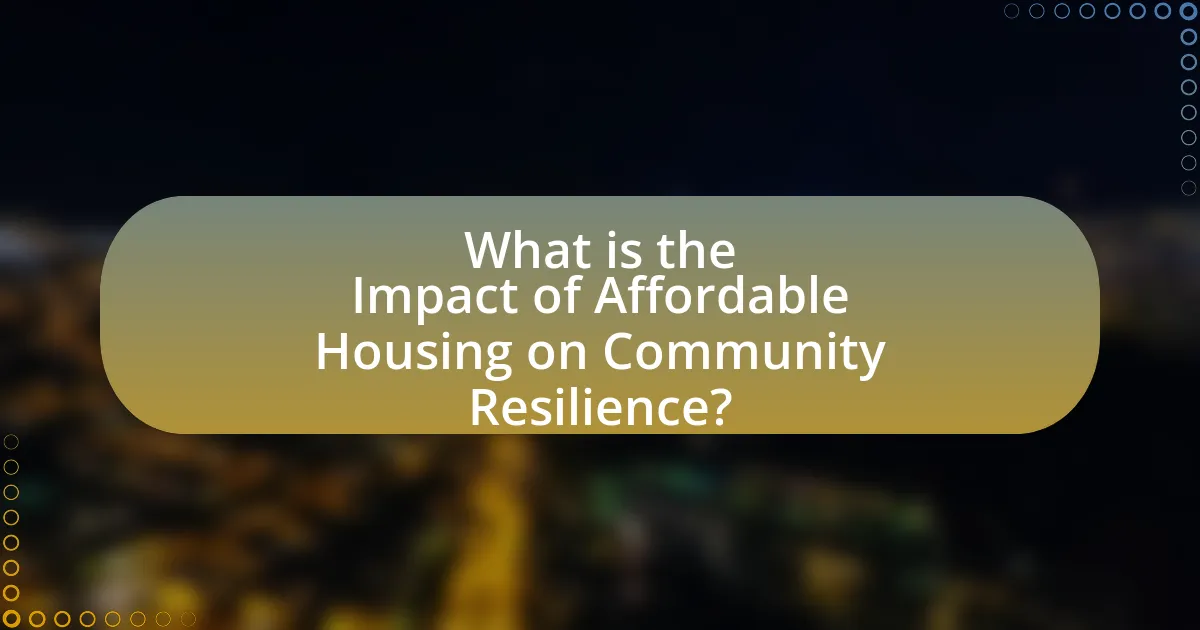Affordable housing is a critical factor in enhancing community resilience by providing stable living conditions that help residents navigate economic and social challenges. The article examines how affordable housing contributes to community stability, reduces homelessness, and positively impacts local economies. It highlights the importance of community resilience, emphasizing social cohesion, economic stability, and adaptive capacity as key components. Additionally, the article addresses the environmental benefits of affordable housing, the challenges in promoting it, and strategies for overcoming these barriers through community engagement and policy advocacy. Overall, it underscores the multifaceted benefits of affordable housing in fostering resilient and sustainable communities.

What is the Impact of Affordable Housing on Community Resilience?
Affordable housing significantly enhances community resilience by providing stable living conditions that enable residents to withstand economic and social challenges. When individuals and families have access to affordable housing, they experience reduced financial stress, which allows them to invest in education, health, and local businesses. Research indicates that communities with higher rates of affordable housing tend to have lower rates of homelessness and better overall health outcomes, contributing to a more stable and cohesive social fabric. For instance, a study by the Urban Institute found that affordable housing can lead to increased community engagement and social ties, which are critical components of resilience during crises such as natural disasters or economic downturns.
How does affordable housing contribute to community stability?
Affordable housing contributes to community stability by providing residents with secure and affordable living options, which fosters long-term residency and community engagement. When individuals and families have access to stable housing, they are more likely to invest in their neighborhoods, participate in local activities, and build social networks. Research from the Urban Institute indicates that stable housing reduces the likelihood of displacement and homelessness, which can destabilize communities. Furthermore, affordable housing can lead to improved economic conditions, as residents are able to allocate more resources toward education and health, thereby enhancing overall community resilience.
What role does affordable housing play in reducing homelessness?
Affordable housing plays a crucial role in reducing homelessness by providing stable living conditions that prevent individuals and families from becoming homeless. When affordable housing options are available, they enable low-income households to secure a place to live without the burden of excessive rent, which is a significant factor contributing to homelessness. According to the National Low Income Housing Coalition, in 2021, there was a shortage of 7 million affordable rental homes for extremely low-income renters, highlighting the direct correlation between the availability of affordable housing and homelessness rates. By increasing access to affordable housing, communities can effectively lower the number of individuals experiencing homelessness, thereby enhancing overall community resilience.
How does affordable housing affect local economies?
Affordable housing positively affects local economies by increasing disposable income for residents, which in turn stimulates local businesses. When individuals and families have access to affordable housing, they spend less on housing costs and have more financial resources available for goods and services. According to a study by the National Low Income Housing Coalition, every $1 invested in affordable housing generates approximately $1.50 in economic activity. This influx of spending supports job creation and enhances community development, leading to a more resilient local economy.
Why is community resilience important?
Community resilience is important because it enables communities to effectively respond to and recover from adverse events, such as natural disasters or economic downturns. This capacity for resilience is crucial in maintaining social cohesion, ensuring public safety, and fostering economic stability. Research indicates that resilient communities can reduce recovery time by up to 50% following disasters, as evidenced by studies conducted by the National Institute of Standards and Technology. Furthermore, communities with strong resilience frameworks often experience lower rates of poverty and improved mental health outcomes, highlighting the multifaceted benefits of resilience in enhancing overall community well-being.
What are the key components of community resilience?
The key components of community resilience include social cohesion, economic stability, and adaptive capacity. Social cohesion fosters strong relationships and networks among community members, which enhances collective action during crises. Economic stability ensures that communities have the resources to recover from disruptions, as evidenced by studies showing that economically resilient communities can bounce back more effectively after disasters. Adaptive capacity refers to the ability of a community to learn from experiences and adjust to changing conditions, supported by research indicating that communities with high adaptive capacity are better prepared for future challenges.
How does affordable housing enhance social cohesion?
Affordable housing enhances social cohesion by providing diverse communities with stable living conditions that foster interaction and collaboration among residents. When individuals and families have access to affordable housing, they are more likely to engage in community activities, participate in local governance, and build relationships with their neighbors. Research indicates that neighborhoods with affordable housing options experience lower levels of social isolation and increased trust among residents, which are critical components of social cohesion. For instance, a study by the Urban Institute found that affordable housing initiatives lead to stronger community ties and greater civic participation, demonstrating the positive impact of stable housing on social networks and community resilience.

What are the specific benefits of affordable housing for communities?
Affordable housing provides numerous benefits for communities, including increased economic stability, improved public health, and enhanced social cohesion. Economic stability is fostered as affordable housing allows low- and moderate-income families to allocate more of their income towards essential needs, thereby stimulating local economies. According to the National Low Income Housing Coalition, every $1 invested in affordable housing generates approximately $1.50 in economic returns.
Improved public health outcomes are also a significant benefit, as stable housing reduces stress and exposure to environmental hazards, leading to lower healthcare costs. The Centers for Disease Control and Prevention highlights that stable housing can decrease rates of chronic diseases and mental health issues.
Furthermore, affordable housing enhances social cohesion by fostering diverse communities where residents can engage and support one another. Research from the Urban Institute indicates that mixed-income neighborhoods promote social interactions and reduce crime rates, contributing to overall community resilience.
How does affordable housing improve access to essential services?
Affordable housing improves access to essential services by reducing the distance and financial burden associated with obtaining those services. When individuals and families have access to affordable housing, they are more likely to reside in areas that are close to schools, healthcare facilities, and public transportation. For instance, a study by the Urban Institute found that low-income households living in affordable housing are 30% more likely to access healthcare services compared to those in unaffordable housing situations. This proximity not only enhances the ability to utilize essential services but also fosters community engagement and stability, which are critical for overall resilience.
What impact does affordable housing have on education and health outcomes?
Affordable housing significantly improves education and health outcomes. Research indicates that stable housing allows families to invest more in their children’s education, leading to higher academic performance and graduation rates. For instance, a study by the Urban Institute found that children in stable housing environments are 30% more likely to graduate from high school compared to those in unstable housing situations. Additionally, affordable housing reduces stress and health-related issues, as families are less burdened by housing costs, leading to better overall health. The National Low Income Housing Coalition reports that families in affordable housing experience lower rates of chronic health conditions, which further supports the link between housing stability and improved health outcomes.
How does affordable housing influence transportation accessibility?
Affordable housing significantly enhances transportation accessibility by locating low-cost living options near public transit systems. This proximity allows residents to utilize affordable transportation methods, reducing reliance on personal vehicles and lowering commuting costs. Studies indicate that areas with affordable housing often experience increased public transit ridership; for example, a report by the American Public Transportation Association found that households near transit services save an average of $9,000 annually on transportation expenses. Thus, affordable housing not only provides economic relief but also fosters greater mobility and access to essential services for low-income communities.
What are the environmental benefits of affordable housing?
Affordable housing provides significant environmental benefits by promoting sustainable land use and reducing urban sprawl. By concentrating housing in existing urban areas, affordable housing minimizes the need for extensive infrastructure development, which can lead to habitat destruction and increased carbon emissions. Additionally, affordable housing often incorporates energy-efficient designs and materials, which can lower energy consumption and greenhouse gas emissions. For instance, studies show that energy-efficient homes can reduce energy use by up to 30%, contributing to a decrease in overall environmental impact. Furthermore, affordable housing developments can enhance public transportation access, encouraging residents to use eco-friendly transit options, thereby reducing reliance on personal vehicles and further decreasing carbon footprints.
How does affordable housing contribute to sustainable development?
Affordable housing contributes to sustainable development by promoting social equity, economic stability, and environmental sustainability. Access to affordable housing enables low- and moderate-income families to secure stable living conditions, which fosters community cohesion and resilience. According to the United Nations, sustainable development goals emphasize the importance of ensuring access to safe and affordable housing for all, which directly supports the reduction of poverty and inequality. Furthermore, affordable housing projects often incorporate energy-efficient designs and sustainable materials, reducing the environmental footprint and promoting long-term ecological health. This alignment with sustainable practices not only benefits residents but also enhances the overall quality of life in communities, demonstrating the integral role of affordable housing in achieving sustainable development objectives.
What role does affordable housing play in reducing urban sprawl?
Affordable housing plays a crucial role in reducing urban sprawl by providing accessible living options within existing urban areas, thereby decreasing the demand for development in outlying regions. When affordable housing is available in city centers or near public transportation, it encourages residents to live closer to their workplaces and essential services, which minimizes the need for long commutes and the expansion of urban boundaries. Studies indicate that regions with higher concentrations of affordable housing experience less sprawl, as they promote denser, more sustainable communities. For instance, a report by the Urban Land Institute highlights that cities with robust affordable housing policies can reduce sprawl by up to 30%, demonstrating the effectiveness of such initiatives in fostering compact urban development.

What challenges exist in promoting affordable housing for community resilience?
Promoting affordable housing for community resilience faces several challenges, including funding limitations, regulatory barriers, and community opposition. Funding limitations arise from insufficient government resources and private investment, which restrict the development of affordable housing projects. Regulatory barriers, such as zoning laws and building codes, can complicate or delay the construction of new housing units. Community opposition, often referred to as NIMBYism (Not In My Backyard), can hinder projects due to residents’ concerns about property values, safety, and neighborhood character. These challenges collectively impede the ability to create sustainable and resilient communities through affordable housing initiatives.
What are the barriers to developing affordable housing?
The barriers to developing affordable housing include high construction costs, regulatory hurdles, and limited access to financing. High construction costs arise from expensive materials and labor, which can significantly increase the overall budget for affordable housing projects. Regulatory hurdles, such as zoning laws and building codes, often complicate the development process, leading to delays and increased expenses. Limited access to financing is another critical barrier, as developers may struggle to secure funding due to perceived risks associated with affordable housing projects. According to the National Low Income Housing Coalition, the lack of affordable housing has reached crisis levels, with a shortage of 7 million affordable rental homes for extremely low-income renters, highlighting the urgency of addressing these barriers.
How do zoning laws affect affordable housing initiatives?
Zoning laws significantly impact affordable housing initiatives by regulating land use, density, and building types, which can either facilitate or hinder the development of affordable housing. For instance, restrictive zoning can limit the construction of multi-family units, thereby reducing the availability of affordable housing options. According to a study by the National Low Income Housing Coalition, areas with more flexible zoning regulations tend to have higher rates of affordable housing development, demonstrating that zoning policies directly influence housing supply and affordability.
What financial challenges do developers face in affordable housing projects?
Developers face significant financial challenges in affordable housing projects, primarily due to limited funding sources and high construction costs. The reliance on government subsidies and grants often creates uncertainty, as these funds can be inconsistent and competitive. Additionally, the rising costs of materials and labor further strain budgets, making it difficult to maintain profitability while adhering to affordability requirements. According to the National Association of Home Builders, the average cost to build a single-family home has increased by over 30% in the past decade, exacerbating the financial strain on developers focused on affordable housing.
How can communities overcome these challenges?
Communities can overcome challenges related to affordable housing by implementing collaborative strategies that involve local governments, non-profit organizations, and residents. These strategies include creating inclusive zoning laws that promote diverse housing options, increasing funding for affordable housing projects, and fostering partnerships with developers to ensure that a portion of new developments is allocated for affordable units. Evidence from the National Low Income Housing Coalition indicates that communities with strong affordable housing policies experience lower rates of homelessness and improved overall community health, demonstrating the effectiveness of these approaches in enhancing community resilience.
What strategies can be implemented to advocate for affordable housing?
To advocate for affordable housing, strategies such as community organizing, policy advocacy, and public awareness campaigns can be implemented. Community organizing involves mobilizing residents to collectively voice their needs and push for local solutions, which has been shown to effectively influence local government decisions. Policy advocacy focuses on lobbying for legislation that supports affordable housing initiatives, such as inclusionary zoning laws, which have been adopted in cities like San Francisco to ensure a percentage of new developments are affordable. Public awareness campaigns utilize media and outreach to educate the community about the importance of affordable housing, as evidenced by successful campaigns in cities like New York that have increased public support for housing initiatives.
How can public-private partnerships enhance affordable housing efforts?
Public-private partnerships can enhance affordable housing efforts by leveraging resources, expertise, and funding from both sectors to create sustainable housing solutions. These collaborations enable the pooling of financial resources, which can lead to the development of more affordable units than either sector could achieve alone. For instance, a study by the Urban Institute found that public-private partnerships can reduce the cost of housing development by up to 20% through shared risk and investment. Additionally, these partnerships often facilitate streamlined regulatory processes, allowing for faster project completion and increased housing availability.
What best practices can communities adopt to maximize the impact of affordable housing?
Communities can maximize the impact of affordable housing by implementing inclusive zoning policies that promote mixed-income developments. These policies encourage a diverse range of housing options, which can enhance social cohesion and economic stability. For instance, cities like Minneapolis have adopted such zoning reforms, resulting in increased housing availability and reduced segregation. Additionally, communities should engage in public-private partnerships to leverage resources for affordable housing projects, as seen in successful initiatives across various urban areas. This collaboration can lead to innovative financing solutions and efficient project execution, ultimately benefiting residents and the local economy.
How can community engagement improve affordable housing projects?
Community engagement can significantly improve affordable housing projects by ensuring that the needs and preferences of local residents are incorporated into the planning and development process. When community members actively participate, they provide valuable insights that can lead to designs that better reflect their lifestyle and cultural context, ultimately increasing the likelihood of project acceptance and success. Research indicates that projects with strong community involvement often experience higher satisfaction rates among residents, as seen in the case of the East Lake Community in Atlanta, where resident input led to a revitalized neighborhood that reduced crime and improved quality of life. This collaborative approach not only fosters a sense of ownership among residents but also enhances the sustainability of the housing solutions implemented.
What role does policy advocacy play in supporting affordable housing initiatives?
Policy advocacy plays a crucial role in supporting affordable housing initiatives by influencing legislation and funding decisions that promote housing accessibility. Effective advocacy efforts can lead to the implementation of policies that increase the availability of affordable housing units, such as zoning reforms and financial incentives for developers. For instance, the National Low Income Housing Coalition reports that every $100 increase in rent can push 2.5 million renters into extreme poverty, highlighting the need for advocacy to secure funding and resources for affordable housing projects. By mobilizing community support and engaging with policymakers, advocacy groups can ensure that affordable housing remains a priority in urban planning and development strategies.


